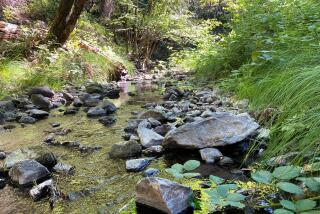Firms to Monitor Runoff to Newport Bay : Algae Problem Tied to Nitrates From Nurseries
- Share via
Although they deny that they are the main source of fertilizer-laden waters flowing into Newport Bay, Orange County’s three largest wholesale nurseries and the Irvine Co. have agreed to monitor water discharges and step up efforts to reduce runoff from their fields.
Executives for Hines Wholesale Nurseries, El Modeno Gardens Inc. and Bordier’s Nursery Inc. say they hope this will avert regulation by a state water quality board, at least until there is sufficient data linking them to an explosive growth of algae and plankton that critics call “the browning of Newport Bay.”
Nutrient-rich runoff from the three nurseries, Irvine Co. crops and reclaimed sewer water discharged by the Irvine Ranch Water District have been cited as the main sources of an estimated 12,000 pounds of nitrates flowing daily into the bay, according to studies by a Newport Beach environmentalist and county environmental quality officials.
The nurseries doubt that they are the culprits.
“Even if runoff from the nurseries were cut off 100%, we are convinced that it would make no difference on the algae problem in the harbor,” Bordier’s president, Lynn Strohsahl, said this week, echoing identical claims by officials for Hines and El Modeno.
“But it has been our attitude from the beginning to work in a spirit of cooperation,” said Strohsahl, whose 205-acre nursery in the foothills above Irvine began last month to operate a long-planned $200,000 water-recycling system to reduce rising water costs.
“We hope that with some scientific analysis and the sheer brain power of everybody involved, there can be a solution to the problem that will satisfy everyone.”
The nutrient-rich flows, according to Newport Beach internist Dr. John F. Skinner and a 1980 study by the Orange County Environmental Management Agency, act as fertilizers, stimulating an overabundance of algae and plankton. The result: Bay water takes on a murky brown color and aquatic life is threatened with a loss of oxygen.
While nitrates pose no threat to public health, Skinner, his wife, Nancy, and local environmentalists suspect that a May 31 die-off of fish and crabs in the Balboa Coves area of the bay was caused by decomposing algae, which depleted oxygen in the water.
High concentrations of nitrates and phosphates have been blamed for the death of aquatic life in freshwater lakes and rivers. In a process known as eutrophication, overstimulated plants and algae eventually exhaust the oxygen needed by other organisms.
Eutrophication generally is not considered deadly to saltwater bays and estuaries because tidal flushing dilutes the chemicals and recharges oxygen levels. But biologists say excessive levels of nitrates may reduce the diversity of marine life, favoring plankton-feeding fish over the sport fish historically found there.
The Santa Ana Regional Water Quality Control Board today will hear a task force report on the nitrates issue, the latest in a host of troubles plaguing the popular West Coast harbor and its companion wildlife reserve upstream.
The nine-member board could take a variety of actions to control the problem, including ordering nurseries and other dischargers to control irrigation runoff flows or halt them altogether. Another course identified by board staff members is voluntary monitoring efforts and water management practices designed to minimize the runoff and fertilizer levels.
Discharges by the water district, which mainly occur during winter months, are expected to be eliminated before the next rainy season when a pipeline will link the district’s system to the Orange County Sanitation District’s ocean outfall four miles off Huntington Beach.
Nursery officials and a consultant to the Irvine Co. said they already have agreed to implement voluntary measures at their expense, whether or not the board acts today.
Hines has agreed to install equipment to monitor water flows from six sites on their 400-acre nursery north of Irvine. Company spokesman Edwin G. (Bud) Summers said the firm will continue a long-term program to install drip irrigation systems. Already, Summers said, the nursery has cut runoff by about 12%. When the $410,000 project is completed within three years, he said, runoff should be cut in half.
El Modeno President Jan E. Groot said his company will monitor a single runoff point and also continue a switch to drip irrigation. Bordier’s also will monitor a single runoff point.
The Irvine Co., which has been in the process of converting to drip irrigation for most of its remaining lands under cultivation, will monitor water runoff at six stations, said Bill Dendy, a consulting water engineer for the company and former head of the state Water Resources Board.
Any stronger measures, nursery owners say, could affect their ability to stay in business here.
“What I worry about is that the nurseries will go to considerable effort and expense to control their nitrogen flows, and there will still be algae growth (caused by) natural sources,” Dendy said. “That’s one of the reasons the monitoring has to be done first.”
“There are no sewers here where we’re at,” Strohsahl said. “For Bordier’s it would cost in the millions of dollars to hook up to the nearest sewer line. That goes beyond an acceptable cost of doing business in the county.”
Said Summers of Hines nursery: “If we find we are a problem, we want to be up front and solve it. But if it’s a $10,000 problem, we want to solve it with a $10,000 solution, not a million-dollar one.”
More to Read
Sign up for Essential California
The most important California stories and recommendations in your inbox every morning.
You may occasionally receive promotional content from the Los Angeles Times.













